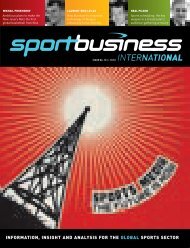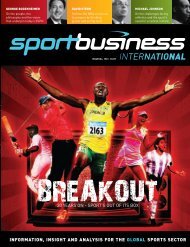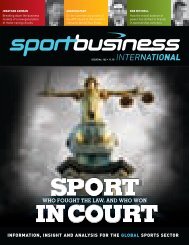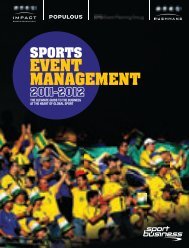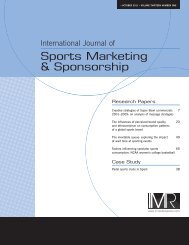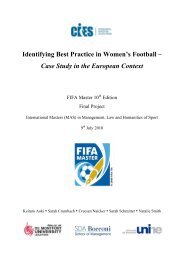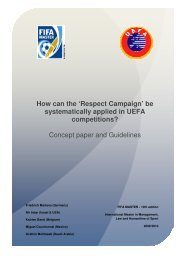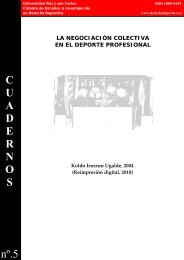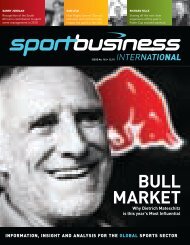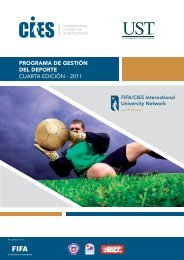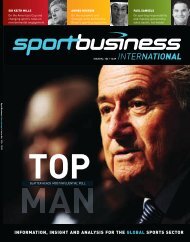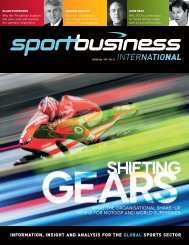Sports Marketing & Sponsorship - FIFA/CIES International University ...
Sports Marketing & Sponsorship - FIFA/CIES International University ...
Sports Marketing & Sponsorship - FIFA/CIES International University ...
- No tags were found...
Create successful ePaper yourself
Turn your PDF publications into a flip-book with our unique Google optimized e-Paper software.
Can sponsorships be harmful for events?RESEARCH PAPERThere are many examples of sponsors influencingthe image of an event. One of the most prominent isthat of the 1996 Olympic Games in Atlanta, whichwas labelled the ‘Coca-Cola Games’ (c.f. Pope et al,1997). In many countries, this negatively affected thecredibility of the Games.Despite anecdotal evidence that a sponsorship caneffect an event’s image and have severe consequencesfor the overall event image, there are no scientificinvestigations relating to this. Moreover, Gwinner(1997) even doubts that such effects actually exist.However, following the clear outline of Ferrand andPages (1999), that a sponsee can also be consideredas a unique brand, it remains unclear why anassociation transfer between two brands should bebelieved to only occur from the brand of the sponseeto the brand of the sponsor and not vice versa. Weaim to test the previous contention of Gwinner andEaton (1999), to explore further the direction ofassociation transfer.Literature review and hypothesisdevelopmentAccording to Cornwell and Maignan (1998),“sponsorship involves two main activities: (1) anexchange between a sponsor and a sponsee wherebythe latter receives a fee and the former obtains theright to associate itself with the activity sponsored; and(2) the marketing of the association by the sponsor.Both activities are necessary if the sponsorship is tobe a meaningful investment”. In line with Cornwell(1995), we take sponsorship to be “the orchestrationand implementation of marketing activities for thepurpose of building and communicating an associationto a sponsorship”. Both definitions emphasise theassociation between the sponsor and the sponsee.Obviously, this association is not restricted to a legalassociation, but actually represents the accumulatedmental associations within consumers’ minds.According to Gwinner & Eaton (1999), sponsors hopethat the consumer will subconsciously linkassociations of the event to associations of thesponsoring company, thereby transferring the image ofthe event to the image of the sponsor. Madrigal(2000) found that through sports sponsorship, acompany can link itself or its product to the strongfeelings a consumer has towards the sponsored team.A company that is able to successfully tap into aconsumer’s psychological connectedness with a sportsteam can encourage greater consumer attachment andcommitment to the sponsor’s brand. Availableempirical evidence on the direction of image transferdemonstrates transfer from the sponsee to the sponsor.This identifies a clear need for further research intoimage transfer through the sponsorship relationshipand the directionality of image transfer. It is apparentthat association of transfer from sponsor to sponseehas yet to receive the attention it deserves. To furtherexplain association transfer, we next discuss twotheories pertinent to this domain: first, the structure ofmemory as represented by the associative networkmemory model; and second, learning theories asrepresented by classical conditioning theory.Humans deal with a vast array of information everyday. An individual is able to function in this complexenvironment through use of cognitive systems (mentalthinking processes) and affective mental systems(feelings and emotions) to evaluate information andsituations as they arise. By these processes, only themost relevant information reaches the mind. The twosystems are interconnected and influence each other(Peter et al, 1999). In order for information to reach aperson, the person has to be exposed to theinformation and has to pay attention. Furthermore, thestimulus needs to be interpreted (comprehension) andmeaning has to be attached. This interpretationprocess can occur by a central route – the use ofcognition – or by the peripheral route to persuasion –the use of cues (Petty et al, 1983). When relevantinformation successfully navigates an individual’sscreening mechanisms and reaches the mind, it hasto be stored. There are many theories concerned withthe organisation of the mind. The associative networkmemory model is commonly accepted (Blackwell et al,246 <strong>International</strong> Journal of <strong>Sports</strong> <strong>Marketing</strong> & <strong>Sponsorship</strong> ● APRIL 2009 ●



